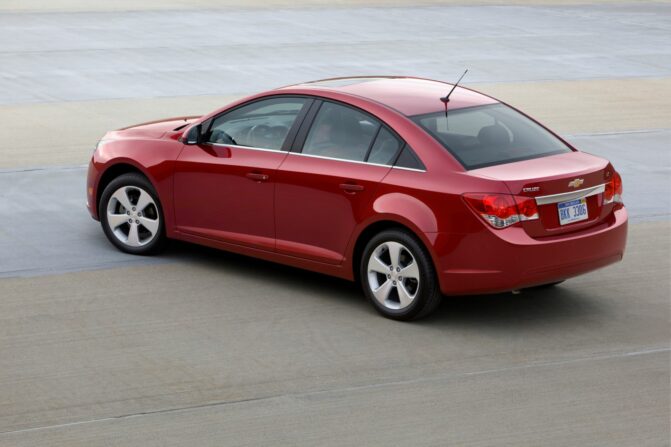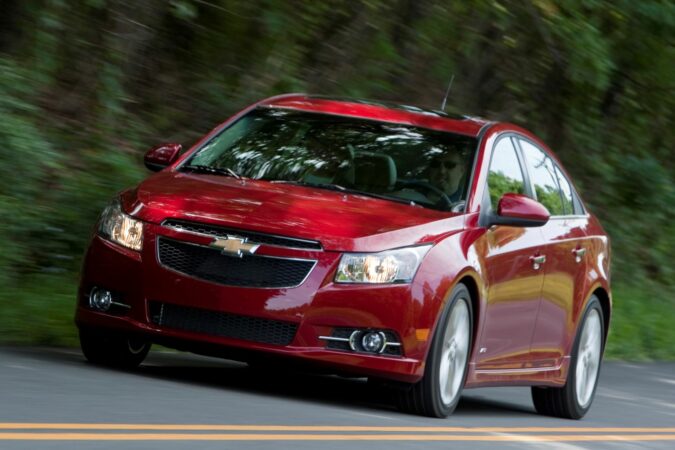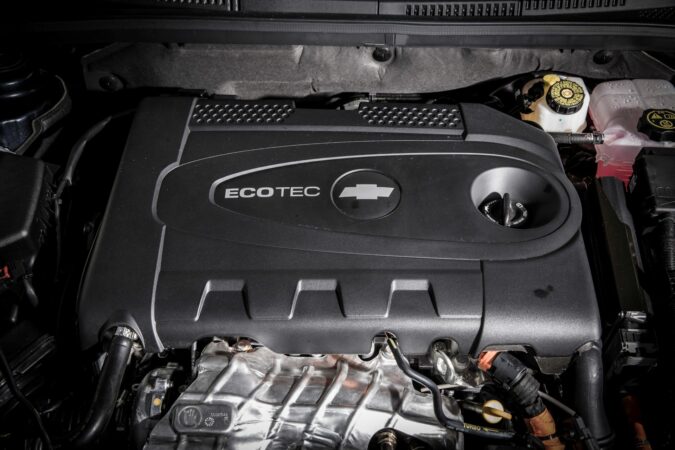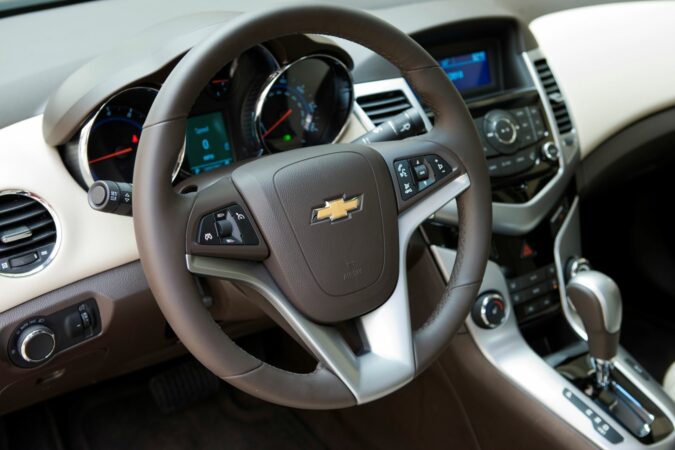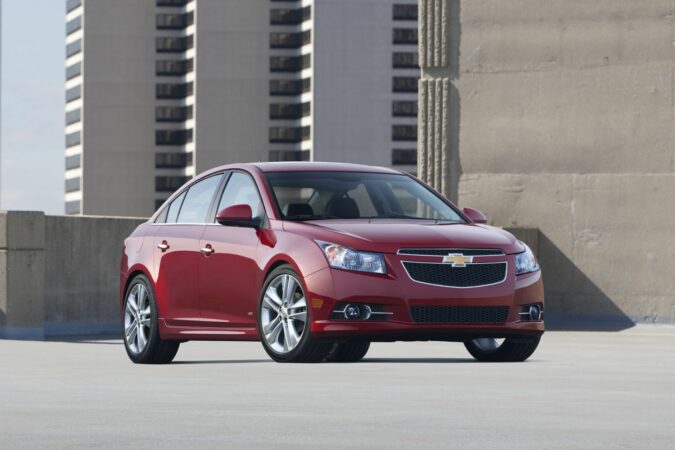If you are an avid automotive enthusiast, you already know about the Chevrolet Cruze. This affordable sedan was one of General Motors’ best-selling vehicles ever made, and still ranks as one of the best family cars to come out of America. But, some model years of this vehicle suffered from serious reliability issues. Today, we’ll be focusing specifically on the 2011 Chevy Cruze problems.
It is important to have a good understanding of the known reliability issues of a vehicle before making a purchase. Not only would this save you thousands of dollars, but it will save you some valuable time as well. And if you already own a Cruze from 2011, today you’ll learn about what potential issues to look out for in the future.
As a start, we’ll give you a brief introduction to the 2011 Cruze. This way, you’ll have a good understanding of what to expect from this vehicle, all of the common problems with the Chevrolet Cruze, and what it has to offer. In doing so, that should give you an idea of whether the Chevy Cruze are good cars.
2011 Chevy Cruze
Although SUVs and crossovers dominate the family car market nowadays, this was not always the case. Back in 2011, people tended to go for sedans as their family vehicles. And, the Cruze was Chevrolets’ main competitor in this segment.
2011 was the first model year of the Chevy Cruze. It replaced the Cobalt and had the Toyota Corolla and the Honda Civic as its main competitors. Although the Cruze was made at the General Motors plant in Ohio, it was designed by a global team of engineers.
The technological features, comfortable interior, and class-leading safety standards made the Cruze an appealing vehicle for most buyers at the time.
2011 Chevy Cruze #1 – Exterior
It is safe to say that the exterior design of the 2011 Chevy Cruze borrowed some inspiration from its bigger sibling, the mid-sized Chevy Malibu. However, Chevrolet didn’t take any major risks with the design, as it had a traditional three-box layout. The arched roofline added some flair to this sedan’s exterior.
2011 Chevy Cruze #2 – Performance
In the aspect of performance, the Cruze had the upper hand over its rivals. There were two main engine options – a 1.8-liter naturally aspired engine and a turbocharged 1.4-liter powerplant. The bigger of the two produced 136 horsepower and was offered with the entry-level “LS” model.
On the other hand, the higher-up LT and LTZ trim levels come with the aforementioned 1.4-liter Ecotec turbo engine. This engine was both more powerful and fuel-efficient when compared to the other engine on offer. The EPA estimated fuel economy of this engine was around 40 MPG.
The Ecotec produced 138 horsepower along with 148 lb-ft of torque, which launched this family sedan to 60 MPH from a standing start in just 9 seconds. Drivers reported that the throttle had a linear feeling, and provided quick responses.
Chevy offered two transmissions with the 2011 Cruze. A manual came as standard, but owners could upgrade to an advanced six-speed automatic for additional performance. This automatic transmission was designed by Aisin and had taller gear ratios which aided the performance.
You could even shift the gears by yourself, but the lack of paddle shifters could be seen as a disadvantage. Although the lack of an independent rear suspension was frowned upon, the watts linkage system more than made up for it. Two suspension tunes were available from the factory.
The Touring chassis was only available with the LT, while the 2LT and LTZ both came with the Sport chassis. Not only that, but the electric power steering system contributed to the sporty driving characteristics.
The braking performance was better in models with the sport chassis models. They had disc brakes on all four wheels, compared to the touring chassis models which only had discs at the front.
2011 Chevy Cruze #3 – Interior And Comfort
Another area where the Cruze stood out from the competition was the interior. Up front, the Cruze has a stylish multitiered instrument panel that wraps around the driver. The rest of the dashboard is covered in high-quality padded materials.
Overall, the passenger compartment of the 2011 Cruze can be considered one of the best cabins seen at the time. The base model came with manual seats, while the higher trim levels were upgraded with power seats. Both these seats were height and tilt adjustable, making them comfortable for even the tallest of drivers.
The vehicle has admirable legroom for its size. The front seats are comfortable and offer ample thigh support, but the rear seats leave much to be desired. Although there is adequate headroom, the legroom is hampered due to the shorter back doors.
Furthermore, the rear seat is not as wide as in its competitors, as it can only fit two adults across. On the other hand, there aren’t many complaints about the cargo space of the 2011 Chevy Cruze. A massive 15.4 cubic feet of cargo can be stored in the rear trunk, and there is even a huge underfloor compartment for additional storage.
Unlike its competitors, the Cruze does not suffer from much wind noise. The triple door seals, acoustic headliner components, and the nylon baffled body panels all do a fantastic job of keeping out the exterior noises, which adds to the comfort.
2011 Chevy Cruze #4 – Safety And Features
The 2011 Chevy Cruze came with many convenient creature comforts as standard. Air conditioning, power accessories, keyless entry, a six-speaker sound system as well as a six-month subscription to GM’s OnStar services were some such features of note.
However, there were some features that were trim-level specific as well. For example, where the 1LT models came with chrome wheels, the 2LT trim upgraded these to 16-inch alloys. Not only that, but the 2LT also came with cruise control, remote start, steering-wheel audio controls, and heated leather seats.
The LTZ model took things up a notch with the inclusion of heated mirrors, automatic climate control, parking assistance, and a sportier-looking gauge cluster. Moreover, it had larger 18-inch alloy wheels with a flangeless design as well.
The 2011 Cruze did not miss out on any safety features. 10 airbags were strategically placed throughout the interior, offering passengers impact protection from all possible directions. It is important to add that the Cruze offered the most airbags out of any car in its segment.
The 2011 Cruze came with a collapsible pedal system. In the event of a head-on or frontal collision, this system reduced the risk of leg injuries to the driver. The OnStar Automatic Crash Response system which automatically notified the authorities and first responders was another notable feature.
All these features contributed to the Cruze achieving great results in almost all crash tests it took part in. The New Car Assessment Program (NCAP) awarded the Cruze five stars in overall safety as well as in every subcategory. Furthermore, the Cruze received the IIHS Top Safety Pick designation for 2011 as well.
Now that you have a clear understanding of what this car had to offer, let’s focus our attention on the 2011 Chevy Cruze problems.
2011 Chevy Cruze Problems
As with any vehicle, the Cruze also suffered from its fair share of Chevrolet reliability issues. Although some of these problems were minor, there were a few that required a large sum of money as well as time to fix properly. Here, we will take a look at a few of the most notorious 2011 Chevy Cruze problems.
- Faulty Power Steering
- Engine Issues
- Coolant Leaks
- Misfires
One of the main issues with the 2011 Chevy Cruze was related to the power steering system. According to some drivers, the power steering system tends to malfunction after driving in a straight line for an extended amount of time. In addition, sudden and complete loss of power steering has been reported as well.
2011 Chevy Cruze Problems #1 – Faulty Power Steering
In a day and age where we have come to depend on this system, sudden failures can have disastrous consequences. Over time, several causes behind the 2011 Chevy Cruze power steering problems have been identified. Worn and damaged pumps are one of the aforementioned causes.
You see, the power steering pump is one of the most important components of the entire system. Although they are known to be fairly reliable, natural wear and tear over years of use is inevitable. Thus, you have to be wary of the symptoms of a bad power steering pump, and consider a replacement power steering pump, if needed.
In addition, excess stress on the power steering belt can damage the pump as well. And when the pump gets damaged, the power steering system of your Cruze will malfunction as a result.
Contamination of the power steering fluid can result in the failure of this system too. Contaminants can leak into the power steering fluid through the various hoses and tubes connected to the system, leading to the formation of air bubbles that disrupt its functionality.
And in the subject of power steering fluid, not having an adequate amount in the system can also result in some issues. Without enough power steering fluid, there won’t be enough force exerted on the steering wheel.
Ideally, you should change the power steering fluid once every two years. If your Cruze is plagued with power steering issues, first take a look at the reservoir tank. If it is running low, refill it to the required level and the problem should go away.
2011 Chevy Cruze Problems #2 – Engine Issues
When talking about the 2011 Chevy Cruze problems, it is hard not to mention the array of engine issues synonymous with this vehicle. Some common engine issues endured by this vehicle include frequent stalling, white smoke coming from the engine, and in the most severe cases – complete engine failure.
Lack of fuel flow to the engine, issues with the sensors, a faulty alternator, inadequate lubrication, blown head gaskets, and using the wrong type of fuel can all result in the above-mentioned engine problems. If you need more insight, check out our detailed write-up on the P0171 error code on the Chevy Cruze.
If your Cruze is affected by one or more of these issues, make sure to take your vehicle to a certified mechanic as soon as possible to get them sorted out.
2011 Chevy Cruze Problems #3 – Coolant Leaks
Coolant leaks are another common 2011 Chevy Cruze problem that has been reported by many owners. If you are unsure about whether your car is suffering from a coolant leak, here are some signs you can use to identify what causes a coolant leak, as well as the symptoms of low coolant levels.
A sweet smell coming from the vehicle is one of the most prominent signs of a coolant leak. On the other hand, the formation of puddles underneath the car and the reservoir running low or empty on coolant are also major indications. More complex issues might include you losing coolant but there’s no leak.
If your vehicle produces a loud gurgling sound from time to time, that is another indication of a potential coolant leak. This noise occurs when air pockets are being pulled into the heater core due to low coolant levels. In other words, you’ll need to learn how to tell if there’s air in the cooling system.
Intermittent heat and the check engine light illuminating along with P0597 to P0599 error codes are two other common signs of coolant leaks.
The cooling system of a vehicle has several hoses connected to the radiator. Issues related to these components, as well as the thermostat housing, are the most common culprits behind coolant leaks. If you locate where the coolant is leaking out from, replacing that individual part might get rid of the leak for good.
If you are a skilled home mechanic, it might be possible for you to fix a coolant leak in your home garage. Otherwise, consider taking your Cruze to a qualified mechanic for repair. On average, the cost of fixing a coolant leak on a Chevy Cruze falls around $50.
2011 Chevy Cruze Problems #4 – Misfires
Inspecting the hoses of the coolant system to make sure that they are in good shape once in a while, and replacing worn-out parts is the best way of avoiding coolant leaks on your Chevy.
Then, we have engine misfires – the final 2011 Chevy Cruze problem we will be taking a look at today. Mainly, misfires on the 2011 Cruze can be caused either by the spark plugs or the vehicle’s ignition coil. So, you’ll have to be wary of the symptoms of a bad ignition coil and consider the replacement cost for an ignition coil.
As you drive your car, the spark plugs inside the engine can naturally wear out. However, a dirty air filter, dirty fuel injectors, and idling for long periods of time can make them wear out prematurely. Some symptoms of faulty spark plugs include poor acceleration and bad fuel economy.
If spark plugs are the reason behind your engine misfires, replacing them will get rid of the issue. You can have a mechanic perform this, or perform the repair at your home garage. On the other hand, if a faulty coil pack is causing the misfires, you must replace that component instead.
Rough idling, increased engine noise, and RPM drops under acceleration are all signs of a damaged or faulty coil pack. To diagnose misfires, you could even plug in an OBD scanner, and note diagnostics error codes such as:
- P0300 Code
- P0301 Code
- P0302 Code
- P0303 Code
- P0304 Code
- P0305 Code
- P0306 Code
Chevy Cruze Years To Avoid
If you think that 2011 is the only Chevy Cruze model year that suffers from reliability issues, you are wrong. There are several other Chevy Cruze model years that also rank among some of the least reliable family sedans ever. If you are on the hunt for a Chevy Cruze to call your own, here are some model years you should avoid.
- 2012
- 2013
- 2014
Years To Avoid #1 – 2012
The first Chevy Cruze model year you should keep away from is 2012. Although the reliability was somewhat improved compared to its predecessor, it was still nowhere near that of its competitors.
The 2012 Cruze was recalled 7 times, which is an alarming amount. Faulty welds on the fuel tank, engine oil spills, problems with the airbags, and the loss of braking assistance were a few of the issues that lead to the 2012 Cruze being recalled.
However, the most severe problem with the 2012 Chevy Cruze that ended up in a recall was the key being stuck in the ignition. This had the risk of making the car roll away and cause accidents. The transmission was another weak area of the 2012 Cruze.
Common failures of this system would occur at around 80,000 miles, and repairs could cost owners upwards of $3000.
Throttle body failure was another common complaint about this model. So, besides diagnosing what does a throttle body do, you’ll have to look out for the symptoms of a dirty throttle body, as well as the symptoms of a bad throttle body.
This would cause frequent losses of engine power, resulting in repair bills close to $450. Additionally, coolant would leak from the radiator, water pump, and engine block itself. This had the risk of overheating the engine, causing further damage.
Some other areas of concern with this model include the turbos, thermostat housing, and overall build quality.
Years To Avoid #2 – 2013
The model that succeeded the dreaded 2012 Cruze was equally unreliable. The transmission issues remained, as did the coolant leaks and overheating problems. Additionally, the 2013 Cruze also suffered from electrical gremlins as well.
Years To Avoid #3 – 2014
2014 Chevy Cruze models, especially the ones equipped with the 1.4-liter engine were notorious for having leaky water pumps. This caused a whole host of issues, including failures of the air conditioning system as well as engine overheating.
So, make sure you diagnose the symptoms of a bad water pump and consider the water pump replacement cost. Due to the extent of this issue, GM had to extend the warranty coverage of the 2014 Cruze to 10 years of 150,000 miles, whichever came first.
During this model year, the Cruze also suffered from coolant leaks. In order to solve this issue, the car thermostat housing had to be replaced. To prevent long-term issues, make sure you’re diligent about the symptoms of a bad thermostat (as is the case with a P0128 code in your Jeep or the P0128 Dodge code), such as P0128 Chevy error codes, and the replacement cost of a thermostat.
Not only that, but the 2014 Cruze also came with faulty PCV diaphragms on the valve cover. This, along with missing air check valves caused an array of engine problems such as excessive oil burn, rough idling, and blue smoke coming out of the exhaust.
In addition to the aforementioned issues, damaged trunk release switches also caused headaches to 2014 Cruze owners.
Best Year For Chevy Cruze
Not all model years of the Chevrolet Cruze suffer from extensive reliability issues. In fact, the latest second-generation models are regarded to be some of the most reliable family sedans around. If you are in the market for a Chevy Cruze, consider getting one made in the following model years.
- 2015
- 2016
- 2017
- 2018
- 2019
Best Chevy Cruze Years #1 – 2015
2015 was the final year of production for the first-generation Chevy Cruze. As a result, most of the reliability woes of the previous models were fixed. Additionally, the front end was redesigned, and a new base model was also introduced.
On the inside, the 2015 Cruze was fitted with some of the latest technical features. 4G cellular connectivity was introduced, and Chevy even enabled WiFi hotspot connectivity through the OnStar system. Cruze owners with Apple iPhones received the benefit of using the Siri Eyes Free smartphone feature as well.
Best Chevy Cruze Years #2 – 2016
In 2016, the Chevy Cruze received its first major redesign since making its debut. The body grew in every dimension, and a host of new colors and infotainment options also made their appearance. The 1.4-liter four-cylinder engine was the standard engine option, and it produced an ample 153 horsepower.
Best Chevy Cruze Years #3 – 2017
Compared to the 2016 model, the 2017 Cruze had relatively few changes. However, these had a huge effect on improving passenger comfort. One notable improvement was the addition of rear seat USB ports, which helped back seat passengers keep their smart devices charged no matter how long the journey was.
Best Chevy Cruze Years #4 – 2018
2018 saw the introduction of a turbo-diesel engine option for the sporty Chevy Cruze hatchback. Additionally, an eye-catching paint finish named Satin Steel Metallic also made its first appearance during this model year.
Best Chevy Cruze Years #5 – 2019
In 2019, Chevrolet upgraded the cosmetics of the Chevy Cruze. The grille as well as the front and rear bumpers were upgraded, as were the taillights. On the inside, the infotainment system was upgraded, and there was also a new interior color for gearheads to choose from.
2011 Chevy Cruze Problems: In Conclusion…
Although the Chevy Cruze offered more features at a lower price compared to its predecessors, there were some model years when the vehicle suffered from a few reliability issues. 2011 is one such year.
Some 2011 Chevy Cruze problems you should keep an eye out for include coolant leaks, engine misfires, and power steering failure. On the flip side, we’ve also looked at common issues that you might notice with other model years of the Chevy Cruze, beyond the 2011 model year.
So, if you need to know the 2012 Chevy Cruze problems, the 2013 Chevy Cruze problems, the 2014 Chevy Cruze problems, and the 2016 Chevy Cruze problems… Check out our extensive discussions and resources on them.
FAQs On 2011 Chevy Cruze Problems
Are Chevy Cruze Good Cars
The reliability of the Chevy Cruze varies depending on the model year. Generally, second-generation cars made between the years 2016 and 2019 are considered to be the most reliable.
How Long Do Chevy Cruze Last
The average lifespan of a Chevy Cruze lies between 150,000 to 200,000 miles. However, proper maintenance is a must if you plan to use your Cruze for this long.
Is Chevy Reliable
Chevrolet is one of the most reliable American car brands. A few of the most reliable Chevy models are the Silverado, Bolt, and Impala.
What Year Did The Chevy Cruze Come Out
The Chevy Cruze made its debut all the way back in 2010. Six years later, Chevrolet updated this family car with a redesigned second-generation model.
Does The Chevy Cruze Have A Turbo
A 1.4-liter inline four-cylinder comes as the base engine option in the Chevy Cruze. This engine produces more than 150 horsepower, which is an adequate amount for a vehicle in this segment.

